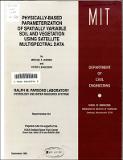| dc.contributor.author | Jasinski, Michael F. | en_US |
| dc.contributor.author | Eagleson, Peter S. | en_US |
| dc.date.accessioned | 2022-06-13T13:13:58Z | |
| dc.date.available | 2022-06-13T13:13:58Z | |
| dc.date.issued | 1989-09 | |
| dc.identifier | 324 | |
| dc.identifier.uri | https://hdl.handle.net/1721.1/143069 | |
| dc.description | Prepared under the support of the NASA Goddard Space Flight Center NAG 5-510 NAGW-1696 | en_US |
| dc.description.abstract | A stochastic-geometric landsurface reflectance model is formulated and tested for the parameterization of spatially variable vegetation and soil at subpixel scales using satellite multispectral images without ground truth. Landscapes are conceptualized as three-dimensional Lambertian reflecting surfaces consisting of plant canopies, represented by solid geometric figures, superposed on a flat soil background. Multiple scattering among landsurface components is neglected. The model is cast within the framework of an existing theoretical model of upwelling solar radiance for optically-thin atmospheres, as observed by a nadir-viewing satellite. A computer simulation program is developed in order to investigate image characteristics at various spatial aggregations representative of satellite observational scales, or pixels. In particular, the evolution of the shape and structure of the red-infrared space, or scattergram, of typical semi vegetated scenes is investigated by sequentially introducing model variables into the simulation. The correlation between canopy and shadow is identified as a principal mechanism contributing to the frequently observed tasseled cap of red-infrared scattergrams of semivegetated landscapes. A Sampling Scale Ratio is formulated as a quantitative criterion that identifies when that correlation occurs. The analytical moments of the total pixel reflectance, including the mean, variance, spatial covariance, and cross-spectral covariance, are derived in terms of the moments of the individual fractional cover and reflectance components. The moments are applied to the solution of the inverse problem: The estimation of subpixel landscape properties on a pixel-by-pixel basis, given only one multispectral image and limited assumptions on the structure of the landscape. The inverse procedure involves the formulation of conditional moments for subsets of pixels that possess similar properties, and that can be identified through their common orientation in red-infrared scattergrams. The analysis is facilitated by assuming geometric similarity among canopy elements and by assuming a functional relationship between fractional covers in the case of large Sampling Scale Ratios. The landsurface reflectance model and inversion technique are tested using actual aerial radiometric data collected over regularly spaced pecan trees, and using both aerial and Landsat Thematic Mapper data obtained over discontinuous, randomly spaced conifer canopies in a natural forested watershed. For the Landsat case, adjacency effects are neglected by assuming low interpixel contrast. Different amounts of solar backscattered diffuse radiation are assumed and the sensitivity of the estimated landsurface parameters to those amounts is examined. | en_US |
| dc.publisher | Cambridge, Mass. : Ralph M. Parsons Laboratory, Hydrology and Water Resource Systems, Massachusetts Institute of Technology, Dept. of Civil Engineering | |
| dc.relation.ispartofseries | R (Massachusetts Institute of Technology. Department of Civil Engineering) ; 89-22. | |
| dc.relation.ispartofseries | Report (Ralph M. Parsons Laboratory for Water Resources and Hydrodynamics) ; 324. | |
| dc.title | Physically-based Parameterization of Spatially Variable Soil and Vegetation Using Satellite Multispectral Data | en_US |
| dc.identifier.oclc | 21467772 | |
| dc.identifier.aleph | 411647 | |
